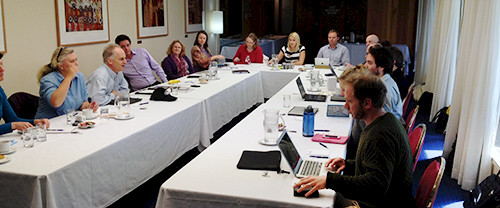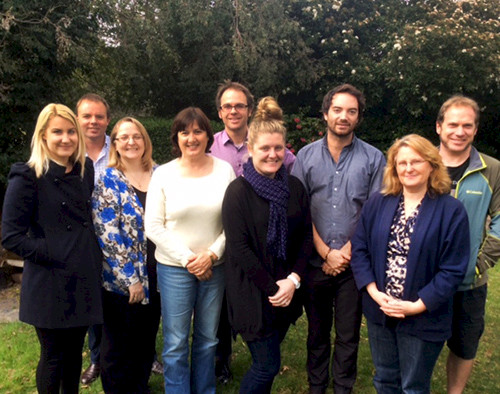USAUS-H2O Canberra workshop
Bill Dennison ·In order to kick off Phase 2 of the USAUS-H2O virtual environmental exchange program between eight high schools in Australia and eight high schools in the U.S., we held a teacher workshop in Canberra, Australia. Judy O'Neil, Simon Costanzo and I traveled to Canberra, the capital city of Australia where our partners from Charles Darwin University organized the workshop at the University House, Australian National University. Andrew Campbell and Emmylou Trombley organized for teachers from eight high schools to attend the workshop. We were joined by staff at the United States embassy (Jason Frohnmayer and Trevlyn Gilmour) and the Australian Department of Education (Kelly Paxman).
The teachers selected for this program were the following: Marcel Brown from Don College in Tasmania, Dan Corke from Kormilda College in the Northern Territory, Chris Main from Clayfield College in Brisbane, Queensland, Kevin McCrohan from Christies Beach High School in South Australia, Susan Nabbs from Notre Dame College in Victoria, Kaitlyn Panzich from Rossmoyne Senior High School in Perth, Western Australia, Sarah Tynan and Susan Rowley from the MLC School in Sydney, New South Wales, Janet Richardson from Lyneham High School in the Australian Capital Territory. Several teachers had participated in Phase 1 (e.g., Marcel Brown, Chris Main, Susan Nabbs and Janet Richardson) and they were able to provide their perspectives on the program and help make improvements for Phase 2.

Each program participant provided a three slide introduction to themselves and their school. Since the first day of the workshop was on the thirteen anniversary of the 11 September 2001 terrorist attack, we also shared our stories of what we were doing thirteen years ago. Trev Gilmour was based at the Australian embassy in Washington, D.C. and had an amazing story of his experiences with the visiting Australian Prime Minister John Howard.
The teachers came from schools in each of the six Australian states (New South Wales, South Australia, Tasmania, Victoria, Queensland, and Western Australia) and both territories (Australian Capital Territory, Northern Territory). These schools ranged from small to large, in quite rural to highly urban regions. Some schools were all girls, and others were coed. They also represent a diversity of climatic environments (from arid, Mediterranean climate to tropical monsoonal climate).
In Phase 1 of this program, we developed six learning modules based on the water cycle; 1) Overview of U.S. and Australia water resources, 2) Source and storage, 3) Distribution and treatment, 4) Usage, 5) Disposal and treatment, and 6) Environmental impacts. As part of the workshop, we decided to add a synthesis module.
The venue at University House was delightful and we met Peter Kanowski, Master of University House, an old friend of Andrew Campbell. We had a group dinner at the University House restaurant, named 'Boffins'. 'Boffin' is not a particularly endearing term for scientists, so it was fun to have a restaurant at one of the prestigious 'Group of Eight' Australian universities named 'Boffins'. It was quite chilly in Canberra, with the spring foliage just beginning to bloom. Canberra is situated near the top end of the Australian Alps or Snowy Mountains and is at ~2000' (~600 m) altitude which contributes to their cool temperatures.

We reviewed the website modules, played a round of 'Conceptionary', developed a schedule for the 2015 educational exchange program, videotaped an introduction from each teacher, and reviewed the evaluations from Phase 1 of the USAUS-H2O program. We also developed a series of video and infographic competitions to be integrated with World Water Day 2014 (22 Mar) and Earth Day 2014 (22 Apr).
Based on the enthusiasm of the teachers, our collective experience in Phase 1 of the project, and the lead time for this next phase, we are very encouraged that Phase 2 will be a meaningful and enriching learning experience for the students involved. We also believe that by engaging the students through video competitions, group projects and adding a synthesis module, we will create an enjoyable program. Our next steps include conducting a teacher workshop in the U.S., developing pairings with the Australian schools, and developing a new synthesis module.

About the author
Bill Dennison

Dr. Bill Dennison is a Professor of Marine Science and Vice President for Science Application at the University of Maryland Center for Environmental Science.
Next Post > Failte gu Alba! (Welcome to Scotland!)
Comments
-
Dota Replay 11 years ago
My partner and I absolutely love your blog and find a lot of your
post's to be precisely what I'm looking for. Would you offer guest writers to write content available for
you? I wouldn't mind writing a post or elaborating on a lot of the
subjects you write concerning here. Again, awesome blog!

